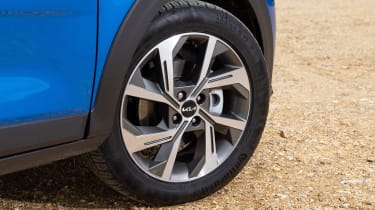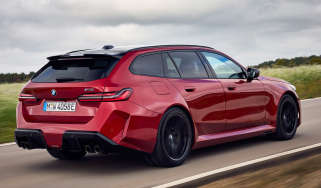Kia Stonic SUV - Engines, drive & performance
The Kia Stonic's relatively firm suspension doesn’t give any tangible benefits
When we drove it, the Stonic felt reasonably agile compared to other vehicles in the segment. This is thanks to relatively firm suspension that stops it leaning too much in corners, and stops the swaying motion some more softly sprung vehicles can suffer from. However, even with better composure through corners, it doesn’t make the Stonic particularly enjoyable to drive.
We found the steering to be overly light and lacking any real feel – the car seems nervous, fidgeting on any imperfect road surface and lacking the composure of models like the SEAT Arona. It's a shame, because the Stonic's firm suspension delivers neither enjoyable handling nor a particularly comfortable ride. Most rivals are able to strike a better balance between the two; although thankfully, Kia has done a good job at eliminating any wind noise in the cabin.
Despite its SUV styling, the car isn’t available with four-wheel drive, as Kia says only around one in 13 buyers of cars in the Stonic’s class ever actually choose it. This helps keep its cost down and should make it more economical.
Kia Stonic petrol engines
Given the turbocharged 1.0-litre petrol engine is both more powerful and more efficient than the now-discontinued 1.4-litre petrol, it’s not surprising that Kia axed the latter. The 1.0-litre petrol produces either 99bhp or 118bhp and the latter gets the car from 0-60mph in a respectable 10.4 seconds (compared to a lethargic 12.2 seconds for the old 1.4-litre engine). It’s 10.7 seconds for the 99bhp engine with a manual, but the automatic is a whole second slower.
The 1.0-litre petrol is quiet and responsive too. It's a touch rattly when you first start it up, but settles down at cruising speed, while the six-speed gearbox is rarely anything other than slick and effortless between gears. There’s a seven-speed dual-clutch automatic gearbox option (on all but the ‘2’ trim), which is a good choice if you need an auto or spend lots of time in stop-start traffic.
Diesel engine
The 1.6-litre CRDi produced 113bhp and claimed a 0-60mph time of 10.5 seconds when it was available. While it had noticeably more pulling power than the petrol engines, it wasn't as fun to use as the 1.0-litre turbo and was prone to an intrusive droning noise at cruising speeds.












